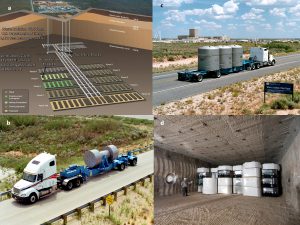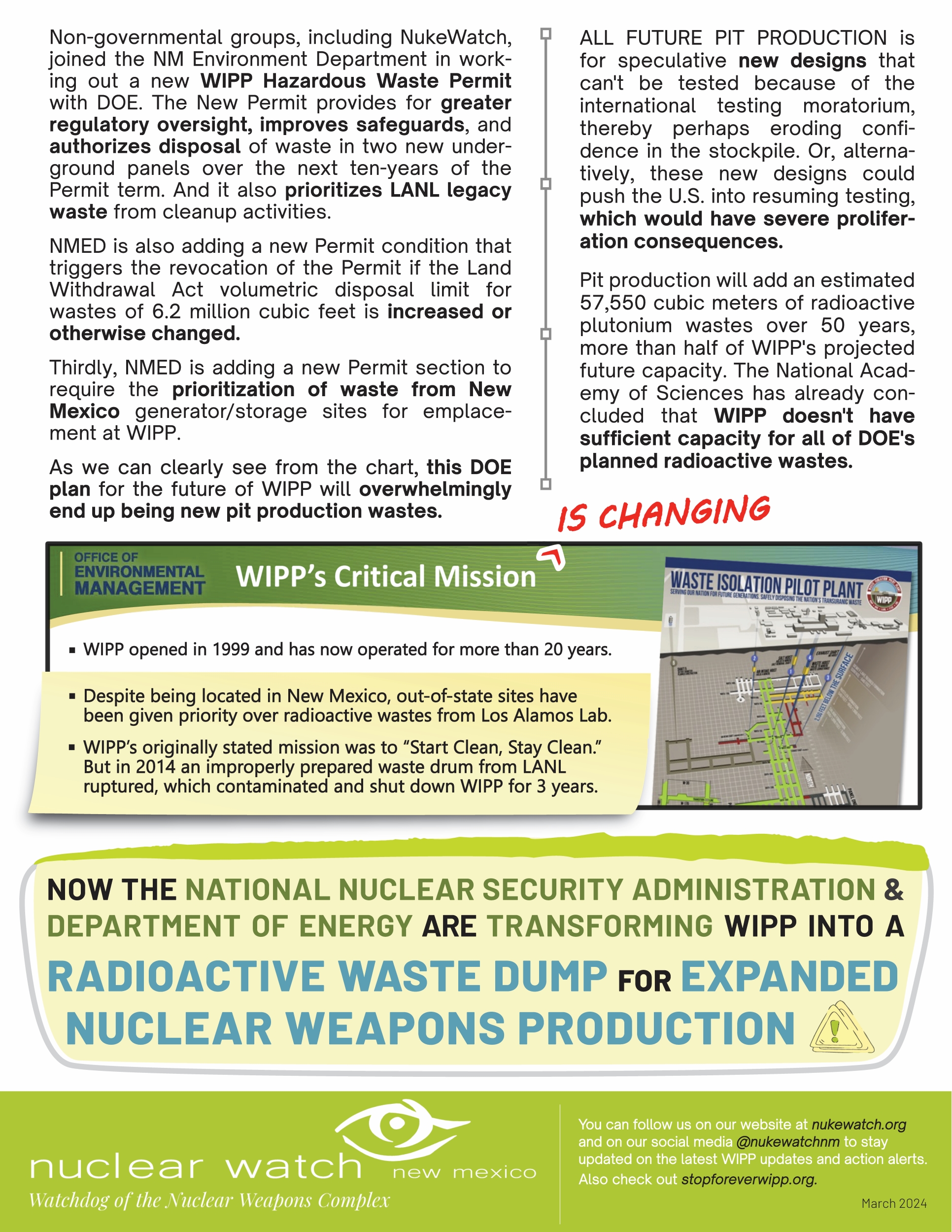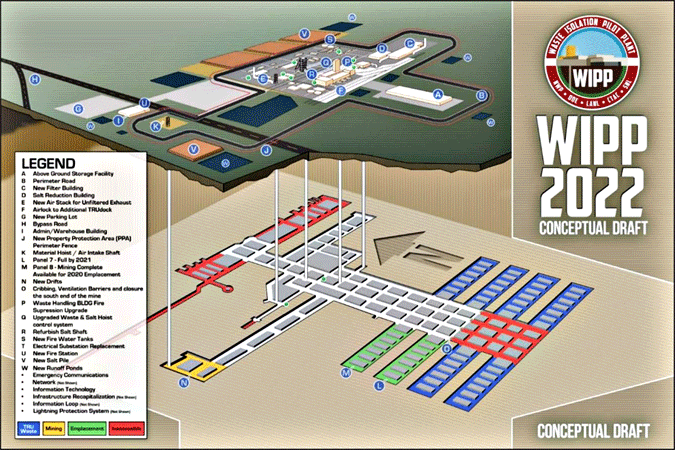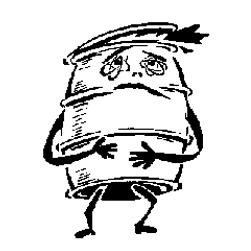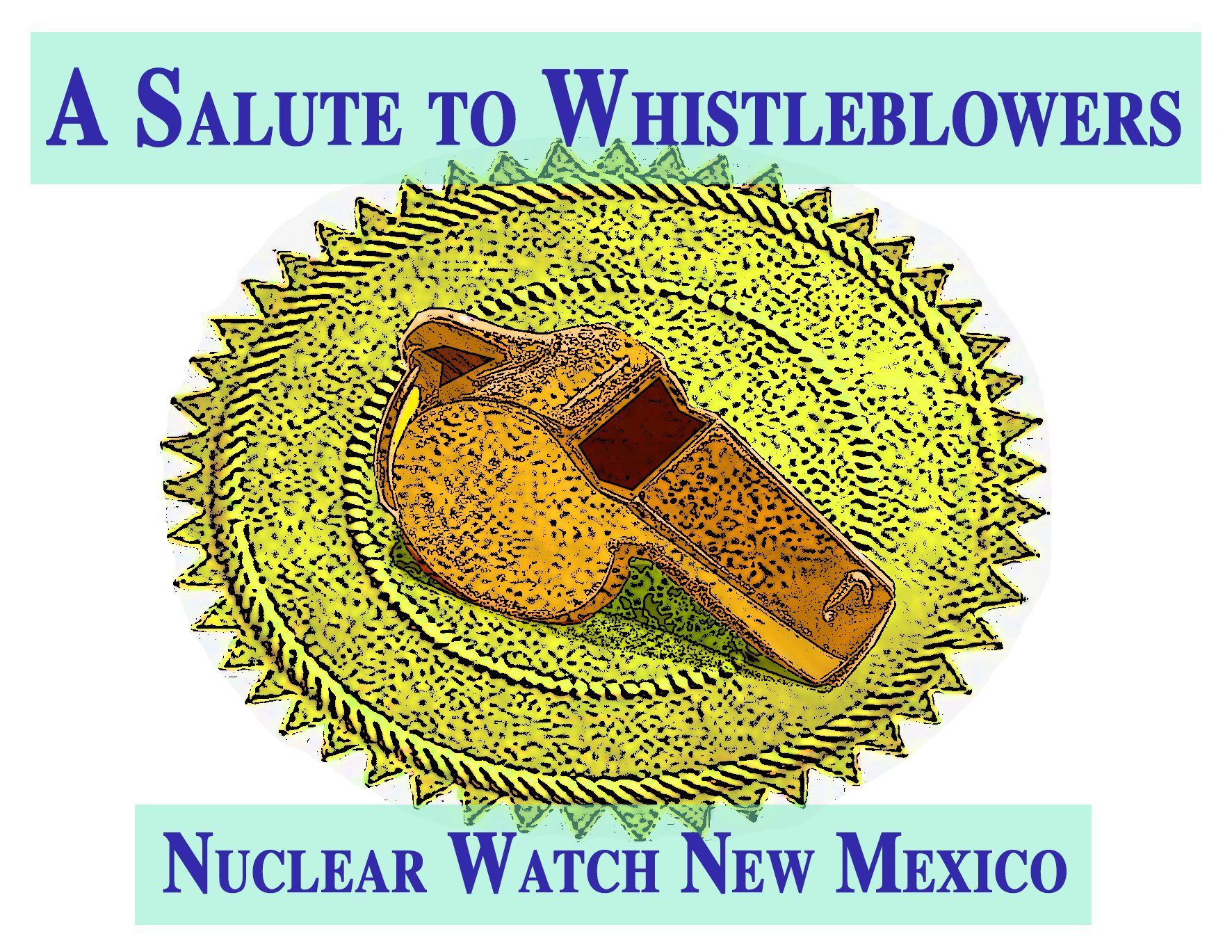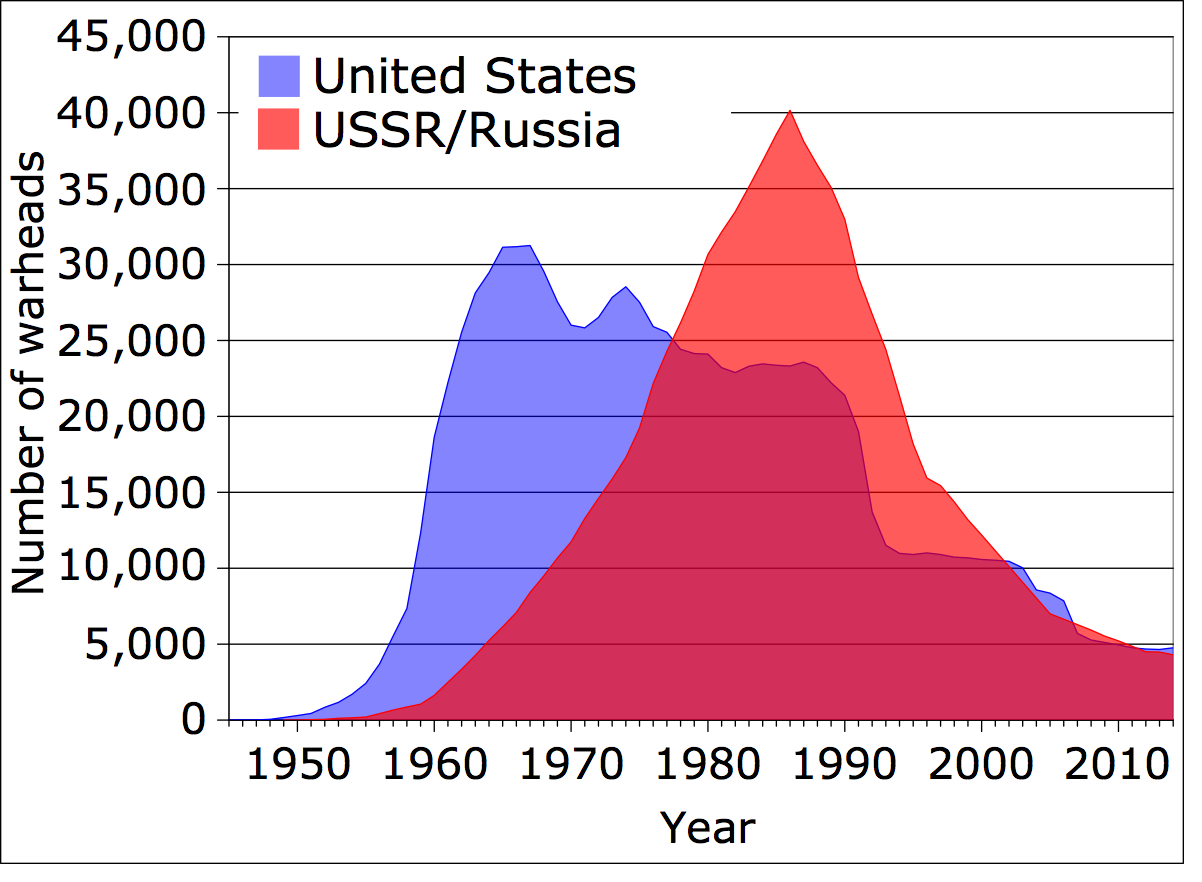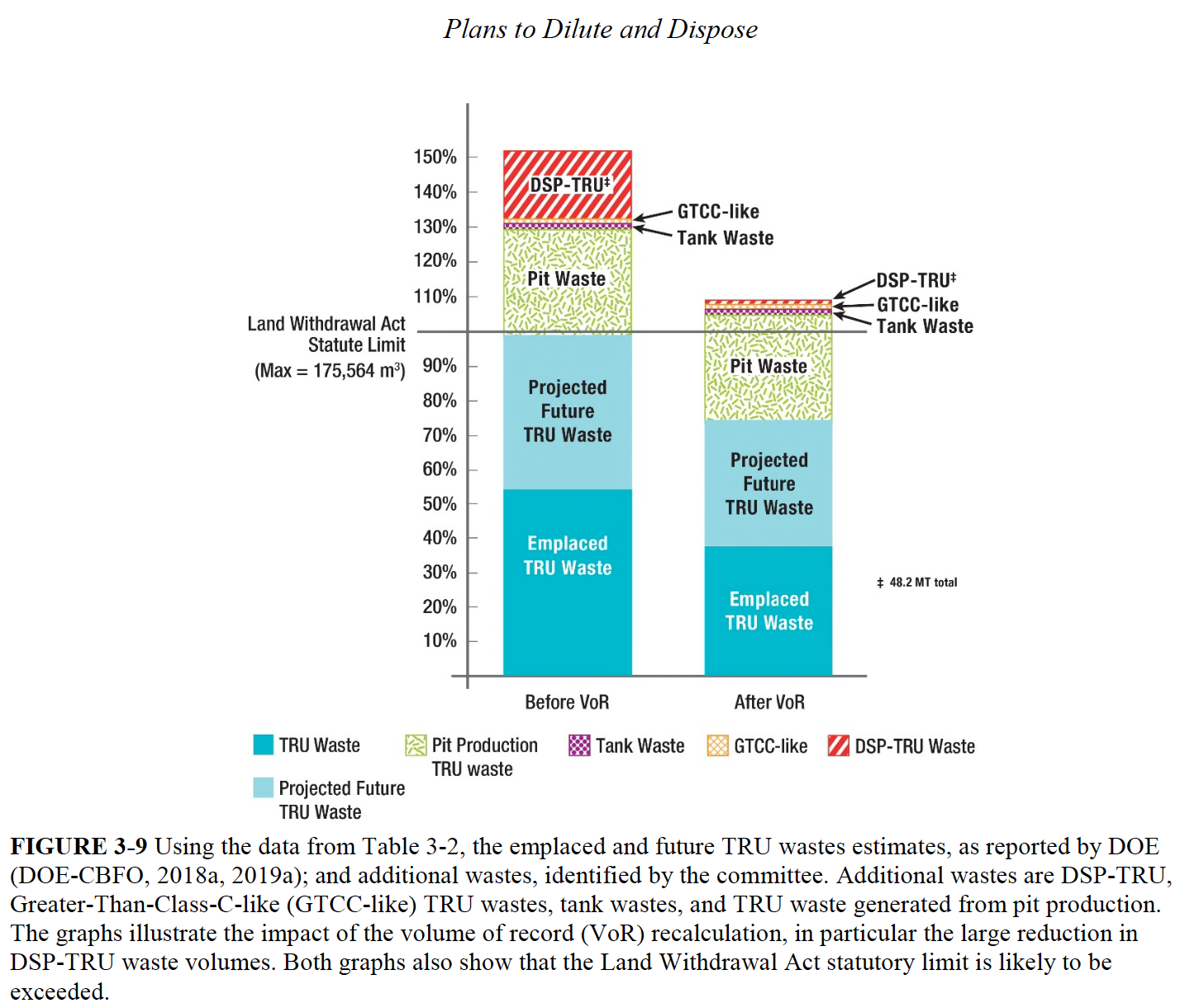Description and Current Mission
The Waste Isolation Pilot Plant (WIPP) is the nation's only deep geologic long-lived radioactive waste repository. Located 26 miles southeast of Carlsbad, New Mexico, the WIPP repository is mined within a 2,000-foot-thick bedded-salt formation. The Underground (U/G) is 2,150 feet beneath the ground surface. WIPP was constructed to determine the efficacy of an U/G repository for disposal of transuranic (TRU) waste. Disposal operations began in 1999 and are scheduled to continue for 35 years. WIPP was constructed for disposal of defense-generated TRU waste from DOE sites around the country. TRU waste consists of clothing, tools, rags, residues, debris, soil and other items contaminated with small amounts of plutonium and other man-made radioactive elements. The waste is permanently disposed of in rooms mined in an underground salt bed layer over 2000 feet from the surface.
TRU waste began accumulating in the 1940s with the beginning of the nation's nuclear defense program. As early as the 1950s, the National Academy of Sciences recommended deep disposal of long-lived TRU radioactive wastes in geologically stable formations, such as deep salt beds.
TRU waste is categorized as "contact-handled" or "remote-handled" based on the amount of radiation dose measured at the surface of the waste container. Contact-handled waste has a radiation dose rate not greater than 200 millirem (mrem) per hour, while remote-handled waste can have a dose rate up to 1,000 rem per hour. About 96 percent of the waste to be disposed at WIPP is contact-handled.
TRU waste is long-lived and has to be isolated to protect public health and the environment.
Four shafts connect the U/G area with the surface. The Waste Shaft headframe and hoist are located within the Waste Handling Building and are used to transport TRU mixed waste, equipment, and materials to the repository. The Waste Hoist can also be used to transport personnel and materials. The Air Intake Shaft (AIS) and the Salt Handling Shaft provide ventilation to all areas of the U/G except for the Waste Shaft station. This area is ventilated by the Waste Shaft itself. The Salt Handling Shaft is also used to hoist mined salt to the surface and serves as the principal personnel transport shaft. The Exhaust Shaft serves as a common exhaust air duct for all areas of the U/G.
History of WIPP
Throughout the 1960s, government scientists searched for an appropriate site for radioactive waste disposal, eventually testing a remote desert area of southeastern New Mexico where, 250 million years earlier, evaporation cycles of the ancient Permian Sea had left a 2,000-foot-thick salt bed.
DOE was authorized by Public Law 96-164, Department of Energy National Nuclear Security and Military Applications of Nuclear Energy Authorization Act of 1980, to provide a research and development facility for demonstrating the safe, permanent disposal of TRU wastes from national defense activities and programs of the United States exempted from regulations by the U.S. Nuclear Regulatory Commission.
Congress limited WIPP to the disposal of defense-generated TRU wastes in the 1992 Land Withdrawal Act. In 1998, the U.S. Environmental Protection Agency certified WIPP for safe, long-term disposal of TRU wastes.
On March 26, 1999, the first waste shipment arrived at WIPP from Los Alamos National Laboratory in New Mexico.
The WIPP Land Withdrawal Act, Public Law 102-579, as amended by Public Law 104-201, authorized the disposal of 6.2 million cubic feet of defense TRU waste at the WIPP facility.
The WIPP facility operates in several regulatory regimes. DOE has authority over the general operation of the facility, including radiological operations prior to closure. The U.S. Environmental Protection Agency (EPA), through 40 Code of Federal Regulations (CFR) Parts 191 and 194, certifies the long-term radiological performance of the repository over a 10,000-year compliance period after closure of the facility. The State of New Mexico, through EPA delegation of the Resource Conservation and Recovery Act (RCRA), has issued a Hazardous Waste Facility Permit for the disposal of the hazardous waste component of the TRU waste. Additionally, the Mine Safety and Health Administration (MSHA) is required to perform four inspections per year of WIPP.
WIPP's disposal rooms are nearly a half mile below the surface (2,150 feet). By comparison, the Empire State Building is only 1,454 feet high.
Browse this page to keep updated on NukeWatch and other local community group's efforts to STOP FOREVER WIPP
STAY INFORMED:
Endless Nuclear Waste Storage in NM?? Not On Our Watch…
Keep up with the Stop Forever WIPP Coalition to learn how to take action against the Federal Government’s Plan to Expand WIPP and keep it open indefinitely.
Visit the Stop Forever WIPP Coalition’s website and social media:
Website: www.StopForeverWIPP.org
Facebook: facebook.com/StopfvrWIPP
Twitter: twitter.com/stopforeverwipp
Instagram: instagram.com/stopfvrwipp
Stay Informed of All Permit-Related Happenings at WIPP! Sign Up for Updates:
The New Mexico Environment Department maintains a Facility Mailing List to which you can add your name and address to get the latest information – just email Ricardo Maestas at the New Mexico Environment Department at ricardo.maestas@state.nm.us and ask to be added to the list. Or mail your request with your mailing address to:
Continue reading→
WIPP News & Updates
New Mexico’s oil fields have a sinkhole problem
The hunt for industrial brine has opened massive and unexpected sinkholes, which is taking delicate work, and more than $54 million, to fill.
“Carlsbad sits on the edge of the Permian Basin, an underground geological formation that stretches from southeastern New Mexico to West Texas and accounted for more than 35% of the U.S.’s domestic oil production in 2019. The surrounding desert is lined with rows of pumpjacks and the occasional white tower of a drilling rig.”
By: Elizabeth Miller | hcn.org
On a July morning in 2008, the ground below southeastern New Mexico began to shift and crack, shooting a huge plume of dust into the air. Within minutes, a massive sinkhole emerged, which eventually grew to roughly 120 feet deep and 400 feet in diameter.
“At the time, it was an unfortunate situation, but most people considered it to be a one-off,” says Jim Griswold, a special project manager with New Mexico’s Energy, Minerals, and Natural Resources Department. But a few months later, in November, dust once again streamed toward the sky as another similarly sized sinkhole opened, cracking a nearby roadway.
Both holes — and later, a third in Texas — emerged at the site of brine wells, industrial wells through which freshwater is pumped into a subterranean layer of salt. The freshwater mixes with the salt, creating brine, which is brought to the surface for industrial purposes; in this case, oil drilling. After the second sinkhole emerged, Griswold’s department head gave him a new task: Characterize the stability of the state’s 30 other brine wells and report back on where the next crisis might arise.
Carlsbad Company Sues WIPP for $32 Million After Air System Subcontract Terminated
“The Program specifically states that ‘construction should not be allowed to proceed until the design is sufficiently mature to minimize change orders,’” the lawsuit read. “No one in NWP’s upper management in Carlsbad had ever borne responsibility for seeing a construction project of this magnitude to completion.”
By: Adrian Hedden | Carlsbad Current-Argus
A $32 million lawsuit brought by a subcontractor at the Waste Isolation Pilot Plant alleged the company that runs the facility breached its contract to rebuild the nuclear waste repository’s air system.
Critical Applications Alliance (CAA), a Carlsbad-based joint venture between Texas-based Christensen Building Group and Kilgore Industries was hired by Nuclear Waste Partnership (NWP) in 2018 to construct the ventilation system at WIPP for $135 million, but its contract was terminated on August 31, about two years into the project.
Known as the Safety Significant Confinement Ventilation System (SSCVS), the system was intended to increase airflow in WIPP’s underground waste disposal area to allow for waste emplacement and mining operations to occur simultaneously.
Available air at WIPP was reduced in 2014 due to an accidental radiological release that led to contamination in parts of the underground.
Subcontractor sues WIPP for $32 million in canceled work
Critical Applications’ ventilation project was tied to a radiation leak in 2014 that often is recalled as the “kitty litter” incident.
BY: SCOTT WYLAND | santafenewmexican.com
A subcontractor is suing the company that operates the Waste Isolation Pilot Plant in Southern New Mexico, claiming $32 million for what it says was gross mismanagement of a major construction project at the nuclear waste disposal site.
In a federal lawsuit, Texas-based Critical Applications Alliance LLC, which was hired to build a ventilation system at WIPP, says Nuclear Waste Partnership was such a disorganized project manager that it caused repeated delays and cost overruns, resulting in multiple breaches of contract.
The subcontractor also complains WIPP managers abruptly canceled its $135 million contract in August with no explanation and without paying millions owed.
U.S. to Launch Minuteman III Missile Test Just Five Days After 50th Country Ratified Treaty on the Prohibition of Nuclear Weapons
“While most of the world’s countries are evolving to a view that nuclear weapons are unacceptable under all circumstances, the U.S. is testing a nuclear missile built to fight the Cold War; one which is designed to cause the indiscriminate slaughter of hundreds of thousands of people.”
By: Sandy Jones | wagingpeace.org

SANTA BARBARA, CA– Early tomorrow morning, between 12:01 a.m. and 6:01 a.m., the United States will launch an unarmed Minuteman III intercontinental ballistic missile from Vandenberg Air Force Base. While the Air Force maintains that missile tests are planned many months in advance, the timing of this test is questionable, at best.
This test will take place just five days after Honduras became the 50th country to ratify the Treaty on the Prohibition of Nuclear Weapons (TPNW). With the 50th ratification, the treaty will enter into force on January 22, 2021. The treaty prohibits the possession, testing, use, or threat of use of nuclear weapons.
Deregulation of Rad Waste Disposal Plows Ahead
Decommissioned Reactors OK-ed for Landfills in Big Gift to Nuclear Industry
By: Jeff Ruch & Kirsten Stade | peer.org
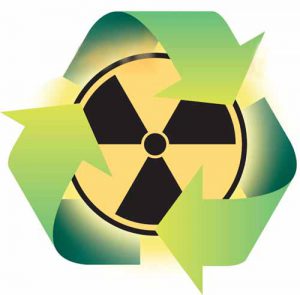 Washington, DC —The Nuclear Regulatory Commission is finalizing a year-long drive to functionally deregulate disposal of massive amounts of radioactive waste. NRC’s plan would allow commercial nuclear reactors to dump virtually all their radioactive waste, except spent fuel, in local garbage landfills, which are designed for household trash not rad-waste, according to comments filed today by Public Employees for Environmental Responsibility (PEER).
Washington, DC —The Nuclear Regulatory Commission is finalizing a year-long drive to functionally deregulate disposal of massive amounts of radioactive waste. NRC’s plan would allow commercial nuclear reactors to dump virtually all their radioactive waste, except spent fuel, in local garbage landfills, which are designed for household trash not rad-waste, according to comments filed today by Public Employees for Environmental Responsibility (PEER).
Today marks the end of public comments for an NRC “interpretative rulemaking” that would, in effect, abrogate longstanding requirements that virtually all such waste must be disposed of in licensed radioactive waste sites meeting detailed safety standards and subject to NRC inspection and enforcement. Instead, NRC would grant generic exemptions for unlicensed waste handlers.
NRC declares its “intent” that these newly exempt disposal sites would be limited to “very low-level radioactive wastes” – a term undefined by statute – which NRC considers to be “below 25 millirem per year.” Yet, NRC’s definition would allow public exposure to the equivalent to more than 900 chest X-rays over a lifetime, create a cancer risk twenty times higher than the Environmental Protection Agency’s acceptable risk range, thousands of times the risk goal for Superfund sites, or enough radiation to cause every 500th person exposed to get cancer.
WIPP gets millions in COVID-19 relief funding, operations contract extended for one year
“Are WIPP workers getting infected at the site and taking it back into the communities?” Don Hancock said. “WIPP is clearly not always a safe place, but we don’t know if WIPP is a place where workers get infected or if infected workers brought it to WIPP.”
BY: ADRIANE HEDDEN | currentargus.com
In August and September, the Waste Isolation Pilot Plant received about $3.8 million per month of federal COVID-19 funding as the U.S. Department of Energy elected to renew the facility’s primary contractor for one year despite an option to keep Nuclear Waste Partnership (NWP) at the helm of the nuclear waste repository until 2022.
NWP spokesman Donavan Mager said the site received $3.816 million in August and $3.803 in September and that the funding was designated to “support operations” although he did not elaborate on how, specifically, the public money was to be spent.
Per the latest reports from WIPP, 39 workers had contracted COVID-19 as the pandemic appeared to pose a resurgence in New Mexico in recent weeks.
WIPP Resumes Nuclear Waste Shipments from California National Laboratory
Nuclear waste shipments to the Waste Isolation Pilot Plant near Carlsbad from Lawrence Livermore National Laboratory (LLNL) near San Francisco, California resumed this month after a 10-year pause.
BY: ADRIANE HEDDEN | currentargus.com
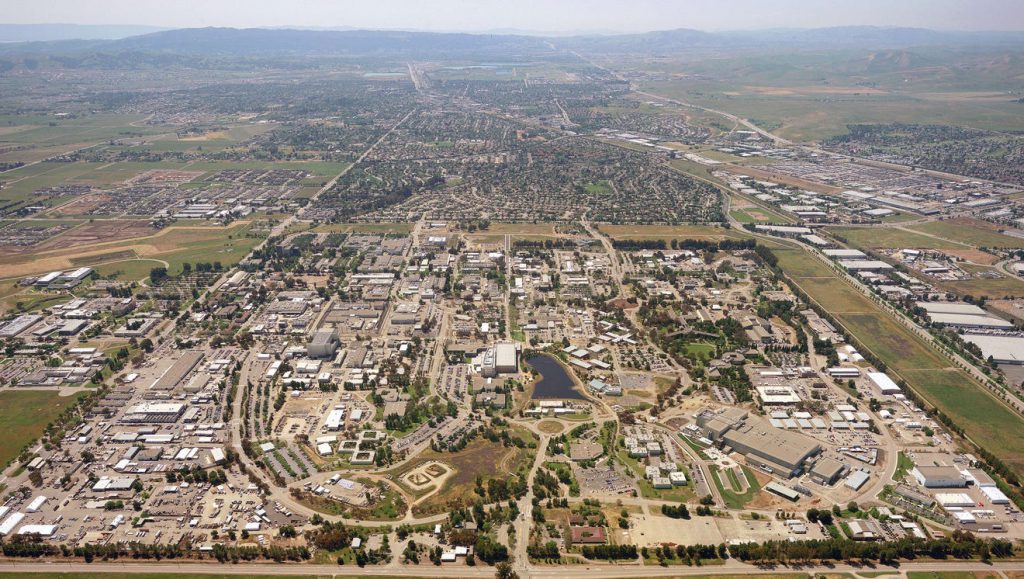
The waste was received at WIPP and will be permanently disposed of in the underground repository about 2,000 feet beneath the surface.
The resumption of shipments from LLNL was the result of a multi-year project and collaboration between the Department of Energy’s Carlsbad Field Office (CBFO), WIPP contractor Nuclear Waste Partnership, National Nuclear Security Administration (NNSA) and the NNSA’s Livermore Field Office, read a DOE news release.
LLNL is primarily a research laboratory that generates transuranic (TRU) waste during its research and engineering operations related to nuclear weapons, plutonium and other technological aspects of the DOE’s nuclear complex.
LANL Could Put Weapons-Grade Waste in WIPP
Tom Clements, executive director of the nonprofit Savannah River Site Watch, said the unspent fuel rods at Los Alamos contain weapons-grade plutonium. He also contended the proposed disposal method is improper and potentially dangerous. The material could get in the wrong hands or a waste barrel could burst, he said
BY: SCOTT WYLAND | santafenewmexican.com
The National Nuclear Security Administration plans to move weapons-grade plutonium from Los Alamos National Laboratory to an underground storage site in Southern New Mexico that nuclear watchdogs say is not intended to hold such high-level waste.
The plan could pose a security risk, argued the leader of one watchdog group, who believes officials should conduct more analysis before moving forward.
About 26.4 kilograms of unspent nuclear fuel rods, which have been stored at Los Alamos’ plutonium plant since 2005, must be cleared out to make room for the production of new pits, the softball-sized cores that trigger warheads, according to an August report.
Groups raise concerns about new shaft at WIPP
“The Southwest Research and Information Center is among those opposing the project. The group filed legal challenges, saying environmental officials ignored existing regulations, past agency practices and case law when giving temporary approval for contractors to begin working.”
BY SUSAN MONTOYA BRYAN | santafenewmexican.com
ALBUQUERQUE — Crews working at the U.S. government’s underground nuclear waste repository in southeastern New Mexico are starting a new phase of a contentious project to dig a utility shaft that officials say will increase ventilation at the site where workers entomb the radioactive remnants of decades of bomb-making.
Officials at the Waste Isolation Pilot Plant near Carlsbad said this week the $75 million project is a top priority and that work will be done around the clock five days a week, with an additional shift on Saturdays. The shaft will eventually span more than four-tenths of a mile and connect to an underground system of passageways.
Cleanup of U.S. Nuclear Waste Takes Back Seat as Virus Spreads
“The coronavirus pandemic demonstrates why we should get cleanup done once and for all,” said Jay Coghlan, executive director of Nuclear Watch New Mexico. “What we do as humans ebbs and flows with history, but the radioactive and toxic wastes that we leave behind last longer than our recorded history. We should be acting now.”
ARTICLE BY: SUSAN MONTOYA BRIAN | santafenewmexican.com
The U.S. government’s efforts to clean up Cold War-era waste from nuclear research and bomb making at federal sites around the country has lumbered along for decades, often at a pace that watchdogs and other critics say threatens public health and the environment.
Now, fallout from the global coronavirus pandemic is resulting in more challenges as the nation’s only underground repository for nuclear waste finished ramping down operations Wednesday to keep workers safe.
Why should NM store nation’s nuclear waste?
ARTICLE BY: LAURA WATCHEMPINO | MULTICULTURAL ALLIANCE FOR A SAFE ENVIRONMENT, PUEBLO OF ACOMA
If the Nuclear Regulatory Commission’s conclusion that it’s safe to move spent nuclear fuel from nuclear power plants across the country to a proposed storage facility in Lea County sounds vanilla-coated, it’s because the draft environmental impact statement for a Consolidated Interim Storage Facility submitted by Holtec International did not address how the casks containing the spent fuel would be transported to New Mexico.
Legacy Nuclear Weapons Maintenance Wastes
Every base where legacy nuclear weapons (early-generation) were deployed (Bomber, Fighter Interceptor Squadrons (FIS), Nike Ajax, BOMARC Missile, ICBM), were maintained, or decommissioned, is potentially contaminated with highly classified 91(b) radioactive material (RAM) from the maintenance of the nuclear weapons during the replacing of the polonium-beryllium (Po-Be) TOM initiators.
BY ANNETTE CARY | georgeafb.info
There is an under-reported news story about radioactive contamination at Air Force bases that were closed and transferred to the public by the Base Realignment and Closure Commission (BRAC).
Most Hanford workers to stay home over coronavirus concerns. No word on for how long
The site in Eastern Washington was used during World War II and the Cold War to produce plutonium for the nation’s nuclear weapons program. It was left massively contaminated with radioactive and hazardous chemical waste, which is being cleaned up now at a cost of about $2.5 billion a year.
BY ANNETTE CARY | tricityherald.com
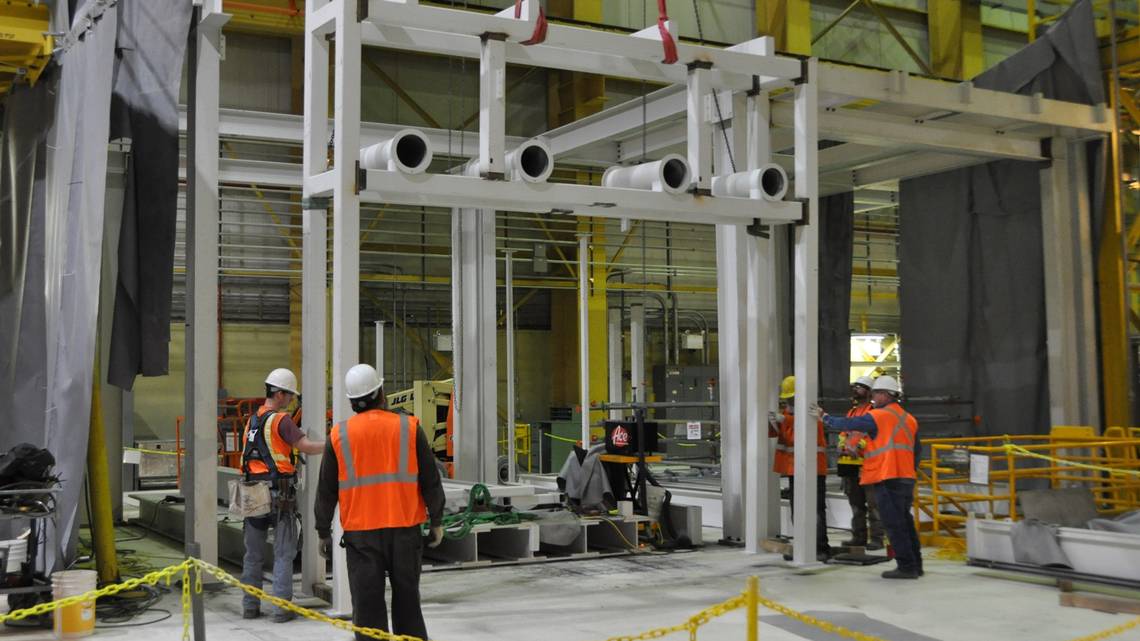
Thousands of Hanford workers will stay home for a second day Tuesday after the Department of Energy announced Sunday evening that the site was going into a temporary planning status to ensure the safety of employees during the COVID-19 pandemic.
Only workers essential to the nuclear reservation’s safety and security should report to work, unless they receive a call from their supervisor saying they are needed for planning work, DOE said.
Hanford employs about 9,300 workers, plus some additional subcontractor employees.
Coronavirus pandemic could delay licensing of nuclear waste facility near Carlsbad
New Mexico’s congresspeople called on the federal government to extend a public comment period for an environmental impact statement (EIS) on a proposal by Holtec International to build a nuclear waste repository in southeast New Mexico.
ADRIAN HEDDEN | currentargus.com
Gov. Chris Christie, Camden Mayor Dana Redd and other officials spoke about the international firm’s role in reviving the city during a Sept. 7 ribbon-cutting.The letter signed by U.S. Sens. Tom Udall and Martin Heinrich (D-NM) and U.S. Reps. Xochitl Torres Small, Ben Ray Lujan Deb Haaland (D-NM), urged the federal Nuclear Regulatory Commission (NRC) to extend the 60-day public comment period until public hearings could be held in New Mexico.
The request followed a State ban on gatherings of more than 10 people amid a global outbreak of coronavirus that left thousands dead across the world.
The comment period began Friday as the draft environmental impact statement was published in the Federal Register.
WIPP Notes Need for Infrastructure Upgrades
DOE hopes to ramp up shipments of nuclear waste to NM repository
BY: ADRIAN HEDDEN | abqjournal.com
Officials from the U.S. Department of Energy are hoping to ramp up shipments of nuclear waste to the Waste Isolation Pilot Plant near Carlsbad to about 17 per week by 2023. The facility is currently accepting about 10 per week. To meet the goal of increasing shipments, Acting Manager of the DOE’s Carlsbad Field Office Greg Sosson said numerous ongoing infrastructure upgrades at the facility were needed.
“Infrastructure ages. We understand we have a lot more waste stream we’re going to tackle,” Sosson said. “These are really good projects to make sure WIPP is sustainable in the future so we can perform our important mission.”
Sosson, at Monday’s annual WIPP Legislative Breakfast in Santa Fe, said officials plan on WIPP accepting up to 350 shipments of transuranic nuclear waste in the next year from numerous DOE facilities, including 80 from Los Alamos National Laboratory and 195 from Idaho National Laboratory.
But to continue to accept waste at an increasing pace, Sosson said the facility must solve its airflow problem.
Hazardous Waste Permit Renewal Begins for LANL
“If DOE and LANL continue to treat the public with disdain, it is going to be a long and difficult permitting process. All in all, this first meeting was disappointing and unproductive.” — Joni Arends, of CCNS
This week the renewal of the New Mexico Environment Department hazardous waste permit for Los Alamos National Laboratory (LANL) began in a very controlled public meeting at the Cities of Gold in Pojoaque. There was no presentation by the Department of Energy (DOE) or its contractor, Triad National Security, LLC, about their plans to renew the application. If the public had questions, they were instructed to write them on a half-sheet comment and question card. There was no explanation about if and how those comments and questions would be answered.
Listen to the full story:
CCNS has prepared a pre-emptive sample public comment letter you can use to express what needs to be included in LANL’s permit application, including proposals to install confined burn and detonation facilities, and coming into compliance with the federal and state hazardous waste laws and regulations dealing with tank systems (that are used to treat liquid hazardous and radioactive waste) and seismic requirements. The last surface rupture on the Pajarito Plateau fault system was 1,400 years ago – thus requiring additional LANL submittals and NMED review. LANL_Permit_Renewal_App_public_comment_120519 The current ten-year LANL permit expires in late December 2020. Under the regulations, the permit application is due to the Environment Department 180 days before the permit expires, or in late June 2020. https://www.env.nm.gov/hazardous-waste/lanl-permit/ The hazardous waste permit renewal application for the Waste Isolation Pilot Plant (WIPP) is on the same timeline. https://www.env.nm.gov/hazardous-waste/wipp-permit-page/ CCNS and others have made numerous requests to both LANL and WIPP management to submit their applications in the spring of 2020 to give additional opportunity for the public to review both. At the meeting, CCNS asked when LANL would submit its application. A LANL staff member said they could not disclose the date.
LETHAL LEGACY: The US wants to bury SC’s plutonium stockpile forever. Its new home isn’t sure it wants it.
WIPP was supposed to be a demonstration for the rest of the country, a test run to see if nuclear waste could be buried in salt elsewhere.
It wasn’t meant to become America’s only nuclear repository — “pilot plant” is in its name — yet today it is. Watchdogs say that by tabbing thousands of barrels of plutonium waste to go there, the Energy Department is reshaping the mine’s purpose.
“What it (implies) is quite dramatic expansion of the Waste Isolation Pilot Plant or another WIPP-like facility somewhere,” said Jay Coghlan, director of Nuclear Watch New Mexico, another watchdog group.
BY: Thad Moore tmoore@postandcourier.com postandcourier.com Nov 23, 2019 Updated Nov 24, 2019
In the time it will take for South Carolina’s stockpile of weapons-grade plutonium to decay, you could repeat most of human history, starting back in the Stone Age.
By the time its byproducts lose the explosive potential to be used in nuclear weapons, some 7 billion years will have passed. The Earth itself will have doubled in age, and then some.
The U.S. government will officially decide in the next few years where the plutonium — the metal used to trigger nuclear weapons — will spend that eternity. And when it does, it will ask another part of the country to bear a profound burden: to house thousands of barrels filled with scraps of the Cold War and America’s nuclear arms race, a legacy that may well outlast our civilization.
That question will soon be posed to New Mexico, where the U.S. Department of Energy has excavated cavernous vaults deep below the ruddy soil in the state’s southeastern corner. The government hopes it will eventually hold tons of plutonium it has decided it no longer needs — enough to build a few thousand bombs the size of the one dropped over Nagasaki, Japan.
If New Mexico says yes, the Energy Department will bury some 20,000 steel drums deep underground there, in a ribbon of salt as thick as Charleston’s Ashley River is wide.
If it says yes, trucks will carry the plutonium load by load down Interstate 20 for the next three decades, and workers will lower it almost half a mile underground, where it will await its final fate: the mine’s slow collapse, and salt entombing it forever.
US, critics split on whether tech made nuke shipments safer
“There’s enough high-level nuclear waste awaiting disposal in the U.S. to fill a football field 65 feet (20 meters) deep. Few states want to house it within their borders.”
“The public defines ‘safe’ as zero risk…the technical community defines ‘safe’ as complying with regulatory standards.” – Robert Halstead, head of the Agency for Nuclear Projects, is currently fighting plutonium shipments to Nevada and spent nuclear fuel transfers to the proposed Yucca Mountain dump.
BY: SCOTT SONNER | phys.org
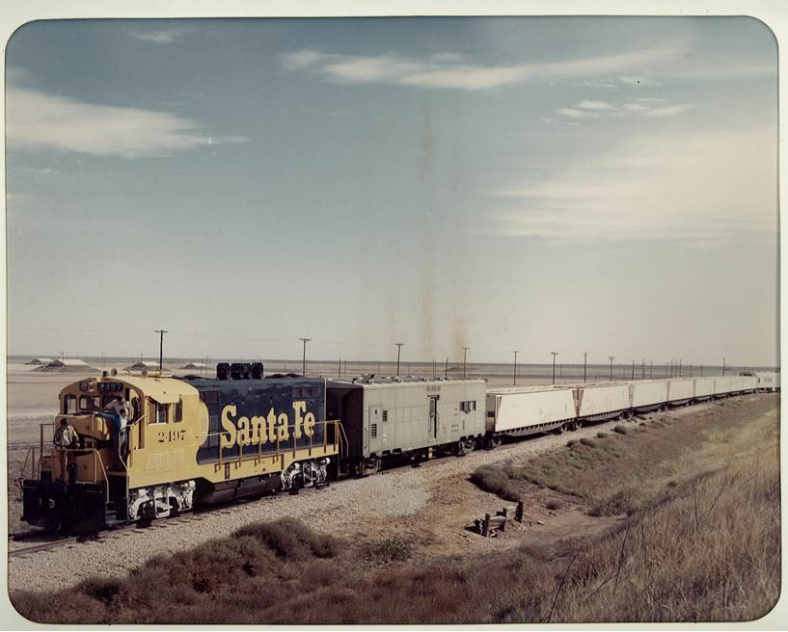
The plutonium core for the first atomic weapon detonated in 1945 was taken from Los Alamos National Laboratory to a test site in the New Mexico desert in the backseat of a U.S. Army sedan.
Officials put other bomb parts inside a metal container, packed it into a wooden crate and secured it in the steel bed of a truck under a tarp, the U.S. Energy Department’s National Nuclear Security Administration says in a historical account.
Grainy black-and-white photos show special agents and armed military police accompanying the shipment nearly 75 years ago.
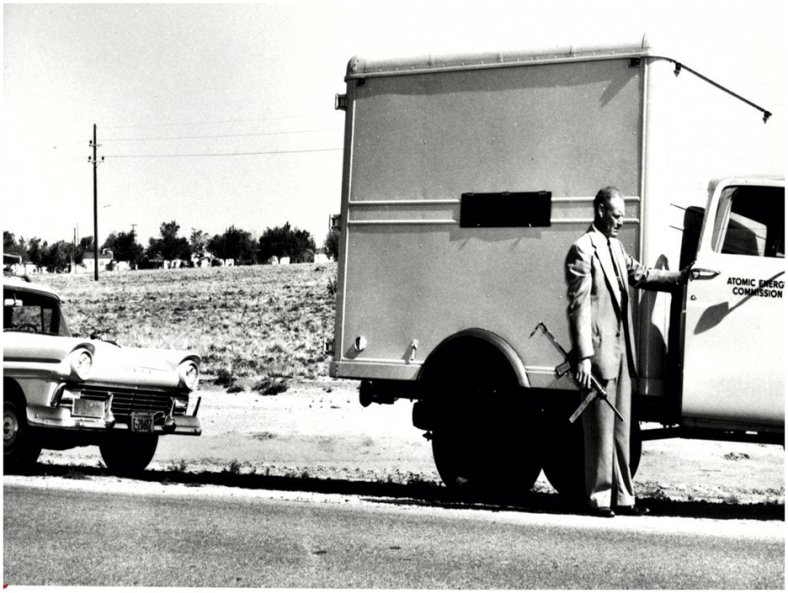
“Nuclear materials transportation has evolved since then,” the department posted online last year.
Today, radioactive shipments are hauled in double-walled steel containers inside specialized trailers that undergo extensive testing and are tracked by GPS and real-time apps.
But whether shipping technology has evolved enough to be deemed safe depends on whom you ask.
Public Hearing on Safety Management of Waste Storage and Processing in the Defense Nuclear Facilities Complex
The Defense Nuclear Facilities Safety Board (DNFSB) held a public hearing on June 20th at its Washington, DC Headquarters. The DNFSB’s goals for the hearing were (1) to discuss Department of Energy (DOE) actions to strengthen the safety posture of solid waste operations and (2) gather information on safety controls to address the vulnerabilities associated with handling and processing solid nuclear wastes.
The Live Stream of the Hearing can be seen here: http://stream.sparkstreetdigital.com/20190620-dnfsb.html?id=20190620-dnfsb
The Board will hold the hearing record open until the close of business on July 20, 2019.
Members of the public can submit written comments to hearing@dnfsb.gov until July 20.
Nuclear Waste Storage Concerns Raised By Panel Members During Santa Fe Forum
BY MAIRE O’NEILL
maire@losalamosreporter.com
Multiple concerns were raised by panel members Wednesday June 21, 2019 during a forum on nuclear waste in the state of New Mexico hosted by the Santa Fe Democratic Party Platform and Resolutions Committee at the Center for Progress and Justice in Santa Fe.
Land Commissioner Garcia Richard said her office has direct oversight of mineral leasing at the proposed Holtec site. She made public a letter she sent to the Nuclear Regulatory Commission expressing her concerns about representations made by Holtec to the NRC and New Mexicans about its control of the proposed site as well as agreements it claims to have secured from the state Land Office. She said while the Eddy-Leah County Energy Alliance LLC privately owns the surface of the proposed site, the State Land Office owns the mineral estate and that has not been disclosed by Holtec.
Permit Changes at WIPP Face Challenges
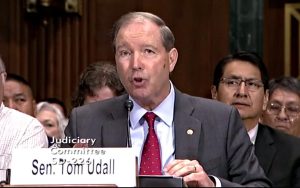
By Mark Oswald | Journal Staff Writer
abqjournal.com | Sunday, January 13th, 2019 at 12:01am
U.S. Sen. Tom Udall is encouraging Gov. Michelle Lujan Grisham’s new administration to reconsider a state government decision made just before she took office Jan. 1 that changes how radioactive waste volume is measured at the Waste Isolation Pilot Plant, in effect allowing more waste to placed in the underground repository near Carlsbad.
Udall said last week that limits on how much waste WIPP can hold were critical to federal-state negotiations that led to WIPP’s creation “and were a major reason New Mexico agreed to this mission in the first place.”
“I am encouraging the new administration to take a hard look at this action, and hopeful that it will pause and reconsider this last-minute change that has major ramifications for our state,” the senator said in an email statement.
The controversial state permit modification for WIPP, approved by then-New Mexico Environment Department Secretary Butch Tongate on Dec. 21, changes the way waste volume is calculated to exclude empty space inside waste packaging. With the alteration, WIPP becomes only about a third full instead of 50 percent full.
→
An inspector monitors radiations around containers at Los Alamos National Laboratory in 2003 prior to shipping nuclear waste to the Waste Isolation Pilot Plant near Carlsbad. New Mexican file photo; Drums of transuranic waste are stored inside a salt cavern at the Waste Isolation Pilot Plant in Carlsbad in 2006. Los Angeles Times file photo
By Rebecca Moss rmoss@sfnewmexican.com
santafenewmexican.com | Jan 5, 2019 Updated Jan 6, 2019
In the final days of Republican Gov. Susana Martinez's administration, the state Environment Department approved a controversial change to how federal officials measure the amount of nuclear waste buried some 2,000 feet underground in Southern New Mexico salt beds.
Proponents of the change say it merely clarifies that the storage site will measure the actual volume of transuranic waste deposited there rather than the volume of the massive exterior waste drums, called overpack containers — and the air inside. But critics say the result will be an increase in the quantity of material stored at the U.S. Department of Energy's Waste Isolation Pilot Plant near Carlsbad.
Several nuclear watchdog groups, which say they intend to appeal the decision, also fear the change in WIPP's hazardous waste permit from the state could open the door to allowing high-level nuclear waste to be brought into New Mexico.
NNMCAB Discusses Potential Impacts of DOE’s Possible Redefinition Of High-Level Radioactive Waste
BY MAIRE O’NEILL
The Northern New Mexico Citizens Advisory Board is asking Department of Energy (DOE) Environment Management and New Mexico Environment Department to address the potential impacts of the possible redefinition of high-level radioactive waste (HLW) for the board.
WIPP: Waste Calculation Change Discussed
BY ADRIAN C. HEDDEN, Carlsbad currentargus.com
WIPP:
“Calculation change will not impact facility’s capacity”
[We at NukeWatch do believe that this proposed change WILL expand WIPP’s capacity and are working hard to stop it.]
Officials at the Waste Isolation Pilot Plant said a proposed modification to facility’s permit to dispose of nuclear waste will have little impact on WIPP operations or its maximum capacity for emplacement. The modification regards how the facility tracks the volume of transuranic (TRU) waste permanently stored in the underground repository.
Critics: WIPP proposal would allow more nuclear waste storage
Critics: WIPP proposal would allow more nuclear waste storage
By Rebecca Moss | sfnewmexican.com
Sep 19, 2018 Updated Sep 19, 2018
As the public comment period closes Thursday on modifications to a state permit allowing the federal government to store nuclear waste at a southeastern New Mexico repository, critics are decrying the changes as an effort to increase storage capacity at the site and are accusing the state Environment Department of rushing the approval process.
The U.S. Department of Energy and Nuclear Waste Partnership LLC, a private contractor that manages the Waste Isolation Pilot Plant in Carlsbad, submitted a request early this year to change the way radioactive waste at the site is measured.
They want to measure the waste by the volume inside each waste drum rather than by the total number of containers at the site. WIPP can store a maximum of 6.2 million cubic feet of transuranic waste — discarded tools, soil and equipment contaminated by plutonium and other radioactive materials — in its underground salt-bed caverns. But its capacity has been measured so far by the total volume of the waste drums, not the materials held inside them.
A Salute to Whistleblowers – Mark your calendar! Sept. 25 at 7pm at CCA
|
NMED Announces Comment Period For WIPP Permit Modification to Change Waste Volume Accounting
In an example of Now-You-See-It-Now-You-Don’t, the NM Environment Department (NMED) is proposing to change their method of measuring waste emplaced into the underground at WIPP. This would would allow 30% more waste into WIPP than is currently allowed. This sleight of hand would be accomplished by not counting the outer-most container of waste packages in the future. This proposal is one piece of a larger plan to bring more waste to WIPP. New Mexicans have already taken enough of the nation”s radioactive waste. More waste increases the the chance of serious accidents leading to dangerous contamination.
Comments are currently due September 20, 2018 at 5pm, but this deadline ridiculously short. Please join us when we ask for an extension.
We will soon post some sample comments and will give updates as soon as NMED posts the Permit Modification online.
See the Notice here – WIPP Class 3 VOR Notice
WIPP Could Get $79M Budget Increase Under Trump’s DOE Funding Proposal
“The potential increase would mark a $79 million boost in WIPP’s funding compared with enacted spending in FY 2017, while several infrastructure projects are ongoing at the site to increase airflow and continue to expand the facility’s underground nuclear waste repository.”
Trump’s Budget Dramatically Increases Nuclear Weapons Work
Santa Fe, NM
In keeping with the Trump Administration’s recent controversial Nuclear Posture Review, today’s just released FY 2019 federal budget dramatically ramps up nuclear weapons research and production.
The National Nuclear Security Administration (NNSA), the Department of Energy’s semi-autonomous nuclear weapons agency, is receiving a $2.2 billion overall boost to $15.1 billion, a 17% increase above the FY 2018 enacted level. Of that, a full $11 billion is for the budget category (Nuclear) “Weapons Activities”, 18% above the FY 2018 level.
Digging deeper under Weapons Activities, “Directed Stockpile Work” is increased from $3.3 billion to $4.7 billion, or 41%. Directed Stockpile Work is the hands on, nut and bolts operations that include extending the service lives of existing nuclear weapons for up to 60 years, while also endowing them with new military capabilities.
STOP FOREVER WIPP! Specific News to WIPP Closing Plans
Nothing Found
It seems we can’t find what you’re looking for. Perhaps searching can help.
Video Presentation on WIPP Expansion - February 5, 2022
Resources & Media
Nothing Found
It seems we can’t find what you’re looking for. Perhaps searching can help.
National Academy of Scientists Report
Review of the Department of Energy's Plans for Disposal of Surplus Plutonium in the Waste Isolation Pilot Plant 2020
Action Alerts
Nothing Found
It seems we can’t find what you’re looking for. Perhaps searching can help.
Quotes
Nothing Found
It seems we can’t find what you’re looking for. Perhaps searching can help.

